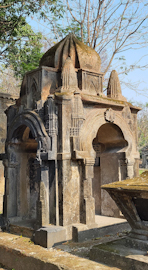Hindoo Stuart and a son of a great author
THE SOUTH PARK Street Cemetery in Kolkata was opened in 1767 and was used as a burial ground for Europeans (mainly British) until 1830. It contains a large collection of funerary sculpture (mostly mausoleums and obelisks), much of which is in the neoclassical style. This now peaceful oasis in central Kolkata with much greenery is the final resting place of many people who had roles in the British East India Company (including its armies) and their families. Although the place contains the remains of many interesting people I will concentrate on two of them, both of whom had military careers.
 Tomb of Hindoo Stuart
Tomb of Hindoo Stuart Charles Stuart (c1758-1828) was born in Ireland (Dublin) and joined the East India Company when aged 19. He served in one of its armies, reaching the rank of Lieutenant Colonel. In India, he was attracted to, and fascinated by, Hindu culture and traditions. He adopted many Hindu ways of life including religious practices. For example, when off duty, he wore Indian clothes and bathed in the Ganges (the Hooghly) daily. In addition, he wrote many articles, published in the newspapers of Calcutta, which extolled the Indian ways of living, and encouraged Europeans to wear Indian garb rather than western clothing. He felt that ladies from Europe would feel more comfortable and look better wearing saris in India. His sympathy for the Indian modes of life and admiration of Indians earned him the nickname ‘Hindoo Stuart’, but did not impede his military career. His funerary monument in the South Park Street Cemetery is in the form of a small Hindu temple, quite different in form from all of the other monuments in the graveyard.
The other military person commemorated at South Park Street has a very modest, barely legible gravestone. It records the death of the short-lived Walter Landor Dickens (1841-1863). He was the fourth child and second son of the author of “Oliver Twist” and many other famous novels: Charles Dickens. Walter became an officer cadet in the East India Company armies, arriving in India in 1857, just before the so-called Indian Mutiny began. After the end of this revolutionary activity and the end of the Company’s rule in India and the start of the British government’s control of the country, he became a soldier in the British Army. Illness resulted in his death in a military hospital in Calcutta.
Walter was buried at the Bhowanipore Military Cemetery in Calcutta. In 1987, some students at Kolkata’s Jadavpur University raised funds and had Walter’s gravestone moved to the South Park Street Cemetery. This was done because it was not being cared for and to honour his father, the famous author.
Having recently become a fan of the novels of Charles Dickens, I was pleased to have been able to view Walter’s gravestone. The lettering on it is legible, but not too easy to read.
During our recent visit to the Cemetery, which we made in December 2024, we saw the two graves mentioned above and many others which we had not noticed on previous visits. For those interested in the early history of Kolkata during its British occupation, the South Park Street Cemetery should not be missed.



